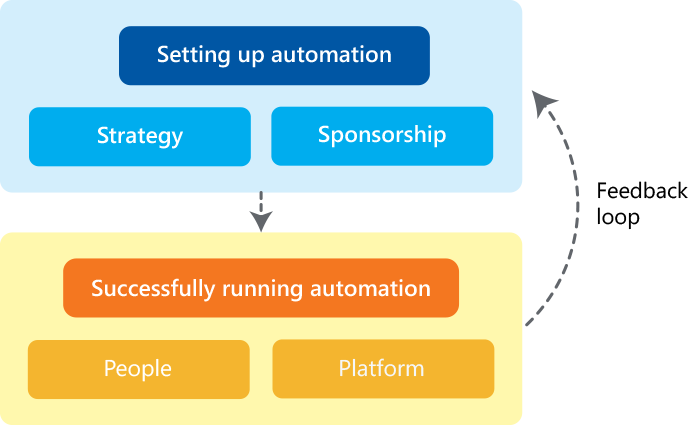Home > AssistEdge > Blogs > Ensuring success on automation singularity journey
Ensuring success on automation singularity journey

The RPA narrative is slowly and steadily settling down.
The industry is graduating from debates on software bots vs humans to deterministic vs cognitive skills of bots. There is a concentrated effort to create a holistic automation strategy covering humans and digital workers and move towards automation singularity. Automation is at the center-stage in board room discussions to drive business acceleration, improve customer experience, and make informed decisions with connected insights. A recent analyst study also reconfirmed that organizations that had invested in automation tools felt better positioned to handle the COVID crisis. In all of this, one thing is sure that the “bots” (aka digital workers) have arrived and are here to stay.
Mélange of digital workforce adoption
Digital workers can take multiple shapes and forms based on business context and automation needs. In its simplest avatar, the digital worker could be a personal assistant to an SME creating daily reports or responding to templatized emails, etc. The complex reincarnations could be digital workers controlling mission-critical systems directly impacting human lives. In addition to process complexity, automation also has to conform to enterprise-grade features like security, compliance, data privacy, reliability, scalability, etc.
Furthermore, operationally some organizations are run via Automation Center of Excellence groups that govern organization-wide deployments and guide automation processes that make their way to production. Other organizations have successfully democratized automation initiatives and have individual departments/business units/geo locations run their automation programs so long as the enterprise concerns like security, compliance, etc. are demonstrated to be in control. There are also success stories of smaller micro-groups in organizations directly using Digital Workers and bringing business process improvements and increasing human user efficiency and effectiveness.
The shape and size of digital worker adoption are thus too vast and varied and no one size fits all.
Setting up successful automation
Despite the diversity, fundamentally four areas define the success of automation programs – Strategy, Sponsorship, People, and Platform. On one hand a good strategy and executive sponsorship helps set-up successful automation programs; and on the other hand skilled people and robust platforms help run the automation programs successfully. There is a lot more going beyond these pillars as well, but the strength (or lack) of these four often dictates the quality and longevity of automation programs in different enterprises.
Each of the above focus areas is nuanced, the right fit definitions are contextual and depend on the size, state, culture, and IT landscape of the target organization. As an enterprise trying to raise the bar on automation adoption, there should be a concentrated effort to give topmost priority to these areas.

Strategy – The focus should be on enabling customer-centric agile implementations and behavior in the organization, utilizing the power of the digital workforce. While RPA tools are quick and easy and have a short cycle time, the strategy should focus on the long-term journey. There should be an adequate emphasis on data-based measurements of automation in action and a robust empirical model-based derivation of automation opportunities.

Sponsorship- Like all other enterprise initiatives, successful automation programs also need the right level of sponsorship to allow programs to find the right balance in each context. This is critical not only to cover costs but also to isolate programs from unforeseen challenges and setbacks. Quite often, RPA programs get stuck after initial implementations due to incorrect prioritization of business processes for automation. Having the right level of sponsorship ensures that the team re-group, learn from the current challenges, and continue chasing the larger automation goals.

People – In the early days, the RPA narrative focused on taking away work from a human. So, it may sound a bit ironic, but humans are the backbone of running successful digital workers. The right set of SMEs who understand the business and all its primary and alternate flows go a long way in setting up successful automation programs. The end game of automation singularity is also about empowering people to work together with digital workers and be more customer-centric in their business.

Platform – Choosing the platform that handles enterprise concerns regarding scale, security and reliability is paramount to success. A platform that runs reliably every time, both in normal conditions and during peak business loads; and ensures compliance to legal and security requirements, goes a long way in building confidence towards taking higher goals on an automation journey.
In short
Each of the focus areas above is equally critical, and focusing only on one or a couple of them is never enough. These areas set a solid foundation to begin the automation exercise in your organization and help you make the most of your investment, as you progress in the automation journey. In almost all AssistEdge automation success case studies, it is evident that organizations that paid equal attention to all the focus areas are the ones who reaped good returns on their investments. So, as an organization whether you are a pioneer in your industry in automation implementations or have just onboarded the automation journey, keeping track of the above four focus areas will help you carve a successful automation story.



Amit Karoliwal
Associate Director - Product Architecture, EdgeVerve
More blogs from Amit Karoliwal >